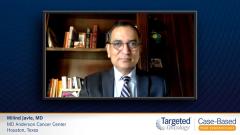
Diagnosing Cholangiocarcinoma: Challenges and Molecular Profiling
Dr Milind Javle discusses challenges that exist in the early identification of cholangiocarcinoma, as well as the benefits of comprehensive molecular profiling.
Episodes in this series

Transcript:
Milind Javle, MD: Because this cancer is relatively infrequent, unfortunately there’s no routine screening for it. However, there should be a high index of suspicion when patients have asymptomatic elevation of liver function tests that seem to persist, unexpected loss of weight, and discomfort in the upper abdomen that cannot be explained. These are some of the common symptoms that persist occasionally for months or even years before patients are diagnosed. The challenges that occur in practice are that most patients are diagnosed at an advanced and an unresectable stage and surgery is not possible, and in fact cure is not possible.
Another confirming factor in diagnosis is that the pathologist will not clearly describe that this is cholangiocarcinoma. They will describe that this is an adenocarcinoma and rule out stomach, rule out upper GI [gastrointestinal], rule out pancreas, rule out cholangiocarcinoma, etc. Therefore, in this situation it’s important that we perform immunohistochemical investigations and really talk to the patient and obtain a history, which may point to a particular primary tumor site. In this case, there was no history. There was very good immunohistochemical analysis that pointed to the site of primary. In my practice I see patients who are referred to me who have undergone a series of tests and sometimes unfortunately unnecessary tests to find the site of primary. Cholangiocarcinoma is essentially established by clinically excluding other sites of primary and by a proper pathology analysis, so really the clues in pathology and biopsy can reveal a diagnosis. It does not need any more fancy complicated investigations.
Molecular profiling has been transformative in the management of cholangiocarcinoma. In fact, if you look at all the GI cancers put together, cholangiocarcinoma has more actionable mutations than any other GI cancer. It’s important that we perform molecular profiling or next-generation sequencing in all patients with cholangiocarcinoma, in my opinion, as early as possible. Going back to some of the studies our group did over 7 or 8 years ago, we found that almost 50% of patients with cholangiocarcinoma, especially intrahepatic cholangiocarcinoma, have actionable mutations in FGFR, IDH, HER2, BRAF V600E, MSI [microsatellite instability], and many other such low-hanging fruit that we can target effectively with approved medications today.
While I say molecular profiling should be done universally in all patients with cholangiocarcinoma and relatively early, clearly there are challenges. Extrahepatic cholangiocarcinoma or hilar cholangiocarcinoma has very little tissue, so we don’t biopsy specimens. Often these are cytology, so you don’t have enough DNA to perform the sequencing. In fact, even in intrahepatic cholangiocarcinoma, which presents as a mass-forming lesion, we should be able to get enough tissue and enough DNA for analysis. However, it depends on the quality of the biopsy. If there’s an FNA [fine needle aspiration] or there’s an ERCP [endoscopic retrograde cholangiopancreatography] brushing, or biopsy through endoscopy, then tissue is not going to be enough. In those situations, perhaps you do need a repeat biopsy. In extrahepatic cholangiocarcinoma, it’s almost uncommon to get a core biopsy with tissue if the tumor is restricted to the hilar.
If there is adequate tissue, we need to do next-generation sequencing. There are several approved commercial panels that test 300 to 400 genes that are of interest for targeted therapy. You must remember that even in patients who don’t have enough tissue, we now have an alternative with circulating tumor DNA. There are very promising platforms where you obtain a vial of blood, it gets spun, and we get information regarding actionable mutations in the blood. The problem with that is the specificity is high, but the sensitivity is low. In other words, not all tumors shed enough DNA to be detected in the blood. Then for some more esoteric tests, for instance, FGFR fusions, they’re not always detectable on circulating tumor DNA testing. It is an evolving field, but clearly it is available, and we should consider it for patients who don’t have enough tissue for molecular testing based on tumor-based biopsy.
Transcript edited for clarity.
---
Case: A 61-Year-Old Woman with Metastatic Cholangiocarcinoma
May 2019
Initial presentation
- A 61-year-old woman presents with jaundice and changes in stool and urine color.
Clinical workup
- Enlarged liver is palpable on physical examination
- Blood work reveals serum levels of CA 19-9 (1400 U/ml), bilirubin 2 mg/dL, ALT 550 U/L, AST 120U/L
- Patient undergoes CT imaging and is found to have multiple liver masses, consistent with metastatic disease or intrahepatic cholangiocarcinoma (iCCA)
- Histopathological examination identifies adenocarcinoma, CK7+, CK20-, HepPAR-, TTF- consistent with cholangiocarcinoma or upper GI Primary
- Patient is diabetic and somewhat non-compliant with her diabetes medication
- Her ECOG PS is 1
July 2019
Treatment
- Patient is treated with chemotherapy (gemcitabine + cisplatin) for 24 weeks.
- Patient is monitored for disease progression every 2-3 months by CT imaging.
July 2020
- Patient does well for 1 year after initiation of treatment but now has elevated CA 19-9 levels.
- MRI scans show several liver and bone lesions but no signs of brain metastases.
- Lab results are normal (absolute neutrophil count 4,000/mm3, platelets 150,000/ml, hemoglobin 12.1 g/dL
- Patient undergoes NGS testing (Foundation Medicine, Inc.) and is found to have FGFR2-BICC1 gene fusion
- Patient meets eligibility criteria for infigratinib phase 2 study and is enrolled in the trial and being treated with infigratinib
- Patient does not show any signs of disease progression on MRI scans for six months, suggestive of stable disease and CA19-9 levels stay within normal limits.








































